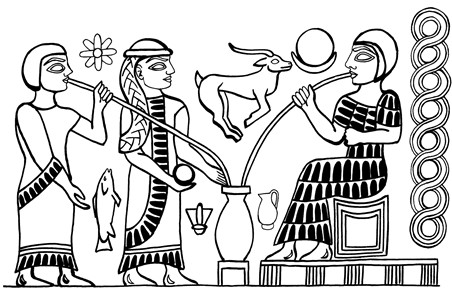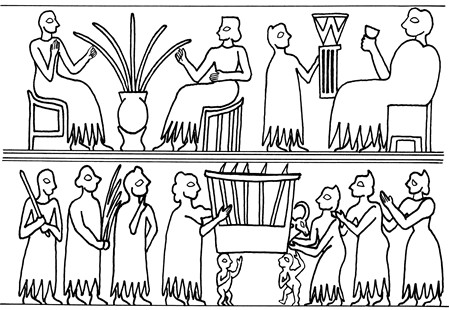Learn the history of beer
One of the oldest drinks people have ever made. Beer dates back to the 5th millennium BC and has been recorded in ancient texts of ancient Egypt and Mesopotamia civilization. Being there for so long, the origin of beer may be just a guess based on archaeological traces.
Discover about the birth of beer
Beer ever since?
By natural fermentation, beer was invented independently among civilizations around the world. Chemical testing of ancient pottery found that beer (similar to wine) was produced about 7,000 BC in Mesopotamia, today Iran.
However, the term 'beer' does not appear soon. The English word 'beer' is said to originate from the word 'beor' - Celtic language, meaning a kind of malt brewed by monks at the North Gaul monastery.
In Mesopotamia , the Sumerian 6,000-year-old painting (with civilization in southern Mesopotamia, present-day Iraq) depicts those who are drinking a drink with the suction from the public bin to be evidence. The oldest about beer.

In their epic Gilgamesh (3,900 years old) contains the oldest surviving beer recipes and the production of beer from barley. This is to pay homage to the Sumerians to the goddess Ninkasi - the god of the beer. And so, beer has become essential for all cereal-growing civilizations in the ancient Western world, especially in Egypt and Mesopotamia.

The Sumerians started the brewing era with 20 "firms": 8 firms used Emmer rice (Triticum dicoccum) . 8 beer companies use vessels (Gerste) and 4 other companies use cereals (Getreidegemisch) . Beer with opaque color does not filter so the drinker must use a straw, export more than 1000km far to Egypt (Egypt / Egypt). The brewing industry is transmitted to neighboring countries in Mesopotamia (brewed with Mesopotamia) and brewed with barley (Hafer), corn (Mais), black wheat (Roggen), wheat (Dinkel), millet (Hirsen ) . The ancient Babylonian dynasty, King Hammurabi had a law to produce beer distributed to everyone as a part of the day according to each class: workers 2 liters, civil servants 3 liters, religious leaders 5 liters . Beer is not sold but exchanged with barley.
In the early days, beer was important to the Romans, but then, during the Roman Republic, wine appeared and became more popular. At this time, beer became a drink considered suitable for barbarians (Hanibal).
- The unexplored truth about beer
- What makes the world's top beer?
- Interesting facts about non-alcoholic beer
The Thracians of the Roman Empire were also known to have used rye-produced beer, even from the 5th century BC. Their name for beer is brutos or brytos .
There is more story, the inventor of the beer is a poor patient, he put hard bread in a glass of soft water to eat, but he left two days after the fermented bread in the glass as a porridge, he eat with a feeling of ecstasy because the breath of yeast afterwards heals. Since then, he has experimented as a recipe to help the medical industry cure and brew beer like holy water.
In the Middle Ages, the monastery was regarded as the leading brewing place, and monks recorded many initial mixing techniques and additional steps to improve flavor and help preserve longer. They often add many different mixes of herbs to beer.
Until about the 9th century, hops began to be grown in France , hops helped to create bitterness in beer and preserve flavor longer. According to the records of the oldest surviving text, the use of hops in beer dates back to 1067 by the abbot and writer Hildegard .

The picture depicts abbot Hildegard.
In Europe, in the Middle Ages, beer was mainly produced in the family. In the 14th and 15th centuries, brewing gradually shifted from family to manual activities, with its beer breweries and monasteries massively consumed.
In the 15th century, in England, beers without hops are known as ales , and the use of hops is called beer. Beer containing hops was imported into England from the Netherlands as early as 1400 in the city of Winchester , and hops were grown on the island nation since 1428.
By the 16th century, ales were used to refer to any strong beer (high alcohol content) , and all ales and beers used hops.
Beer production in the 16th century
In 1516, William IV, Duke of Bavaria, adopted the Reinheitsgebot (Pure Law) , presumably the oldest food rule.

Brewing in the 16th century.
The Gebot stipulates that the composition of beer only includes water, barley, beer and yeast added after the invention of Louis Pasteur (1822-1895) in 1857.

Louis Pasteur is a scientist who invented brewer's yeast.
The laws of the Bavarians were applied throughout Germany as part of the unified Germany in 1871 into the German Empire under Otto von Bismarck , and have since been updated to reflect modern trends in production. alcohol export. So far, Gebot is still considered the standard of purity for beer, although this can be controversial.

Beer ale.
Most beers until recently have actually been what today is called ales .
Lager beer (cold beer) was discovered by accident in the 16th century after beer was stored in the cold cellars for a long time, since then it has been produced more than ales.
Breakthroughs in production
"With the invention of the steam engine in 1765, industrialization of beer production has come true. New innovations in brewing technology have appeared with the advent of thermometers and hydrometer. In the nineteenth century, beer producers allowed them to increase their effectiveness and control their alcohol content.
Until the end of the 18th century, malt was mainly dried by fire by burning wood, charcoal, rice husk, and after 1600 was from coke. In general, none of these types of malt are well shielded from the smoke produced in kilns, and therefore the beers of that time have the smoke content in their flavors.
The invention of the drum-shaped oven in 1817 by Daniel Wheeler allowed the creation of a well-cooked malt malt and paved the way for the production of stout (porter and stout) . The invention of the role of yeast during fermentation in 1857 by Louis Pasteur helped brewers to prevent the sourness of beer by unwanted microorganisms. "

October 4, 1842, at St. Market Martin in Pilsen, Josef Groll has launched a beer that changes the way that the whole world has looked at beer so far, which is a yellow beer with a slightly dark , characteristic aroma and transparency to penetration.

News about special beers in Pilsen spread throughout Bohemia. The new railway and Pilsner beer are quickly favored by German and French tourists, confirming the appeal of the famous Pilsen beer around the world.
But often, success always creates competition. The original yellow beer of Josef Groll quickly has many fake beers, many of which claim to be Pils, Pilsen or Pilsner beer whether or not they come from Pilsen region. In fact, Pilsner today became a worldwide name for any yellow beer fermented from the bottom of the barrel.
In 1953, New Zealander Morton W. Coutts developed a continuous fermentation technique . Morton patented his technology and it was a revolution in the beer industry because it reduced the incubation time and beer production was previously 4 months to less than 24 hours. His technology is still used by many of the world's largest brewers today.

Today, beer has become popular, the beer industry is particularly developed, beer has become more diverse in form and variety and beer has become one of the most popular drinks in the world.
- The unexplored truth about beer
- Beer and 24 mysteries that you can't expect
- 9 interesting things about beer
- There is going to be brewed dry beer like coffee
- Can beer be seduced by drinkers?
- What makes the world's top beer?
- Interesting facts about non-alcoholic beer
- Video: Boil beer on a hot pan
- Is beer really good for your hair?
- 10 great reasons to drink beer
- Why is beer pouring out better than drinking from cans?
- Sixth graders make beer for the universe
 'Fine laughs' - Scary and painful torture in ancient times
'Fine laughs' - Scary and painful torture in ancient times The sequence of numbers 142857 of the Egyptian pyramids is known as the strangest number in the world - Why?
The sequence of numbers 142857 of the Egyptian pyramids is known as the strangest number in the world - Why? History of the iron
History of the iron What is alum?
What is alum?